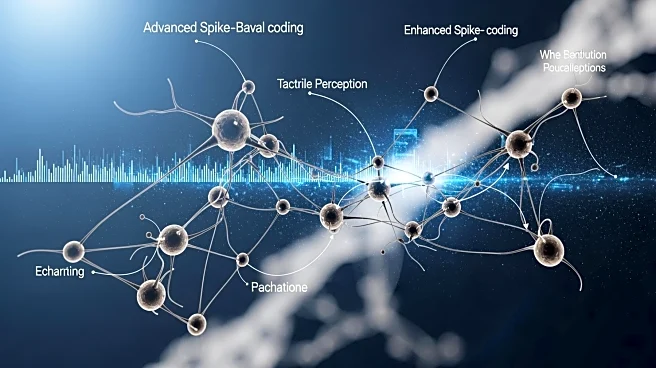What's Happening?
Recent research has focused on improving spike-based neural coding for tactile perception systems, which are crucial for developing advanced neuromorphic engineering applications. These systems aim to
mimic biological nervous systems by using spikes as fundamental units for encoding and transmitting information. Two primary hardware implementations have been explored: voltage-controlled oscillators (VCOs) and ring oscillators (ROs). VCOs convert analog voltage inputs into frequency-modulated digital signals, which are then transformed into spike signals. ROs, constructed with printed organic circuits, generate voltage spikes based on input stimuli. These methods facilitate rate coding, allowing the systems to encode stimulus intensity and duration. Additionally, spiking neuron interfaced sensing, using models like the leaky integrate-and-fire (LIF) model, offers a way to emulate biological neuron behavior. Memristor-based devices are also being developed to construct artificial spiking neurons, providing energy-efficient solutions for tactile neural systems.
Why It's Important?
The advancements in spike-based neural coding are significant for the development of neuromorphic systems, which have the potential to revolutionize robotics and artificial intelligence. By mimicking the brain's processing capabilities, these systems can enhance sensory integration and improve the efficiency of data processing. This technology could lead to more sophisticated robots capable of complex interactions with their environment, benefiting industries such as healthcare, manufacturing, and consumer electronics. Furthermore, the energy-efficient nature of these systems addresses the growing demand for sustainable technology solutions, potentially reducing the environmental impact of electronic devices.
What's Next?
Future developments in spike-based neural coding may focus on further integrating multiple sensory modalities to create more comprehensive neuromorphic systems. Researchers are likely to explore ways to minimize system complexity while maintaining efficient designs. The use of memristors and self-powered sensing mechanisms could be expanded, offering new opportunities for creating autonomous systems with reduced energy consumption. Additionally, advancements in artificial neural networks may enhance the decoding of multisensory information, paving the way for more intelligent and adaptive systems.
Beyond the Headlines
The ethical implications of neuromorphic engineering are profound, as these systems could lead to machines with capabilities resembling human cognition. This raises questions about the role of artificial intelligence in society and the potential need for regulations to ensure responsible development and deployment. Moreover, the cultural impact of such technology could shift perceptions of human-machine interactions, influencing how society integrates these systems into daily life.











